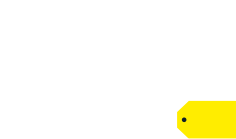Receive-Ready Cartons
RDC Inbound Shipping Guide
Table of Contents
Introduction:
- Regional Distribution Centers (RDCs)
- Best Buy Business Days
- Vendor EDI Requirements
- Packaging, Environmental and Recycling Attributes
Sections:
- Best Buy Receive-Ready
- Receive-Ready Items (SKUs)
- Receive-Ready Cartons
- Receive-Ready Pallets/Bundles
- Receive-Ready Trailers
- Receive-Ready Documents
- Receive-Ready Appointments (Scheduling)
- Additional TV Requirements
- Premium Design Center (PDC DC) Requirements
- Courier Door
- Collect Vendor Routing and Shipping
- Collect Carrier Tender and Shipping
- Terms and Definitions
Receive-Ready Cartons
Published 10/02/2018, 10:07 PMQuestions about this section? Contact Dist_Ops_Support@bestbuy.com.
3.1 Case Pack Quantity (CPQ) Approval Process
Prior to item induction, discussions around the following considerations should take place with Best Buy Demand Planning:
- CPQ is the BBY purchase order unit of measure and must align with the carton shipping configuration.
- If inners cartons exist, they are typically the DC-to-store replenishment unit of measure.
CPQ Change Request (change existing CPQ):
- Prior to shipping a new CPQ configuration, vendors must email both the BBY Demand Planning Analyst and their corresponding BBY Demand Planning Manager to request CPQ approval.
- If email-approval is received, vendor must initiate a firm stop date to discontinue shipments of the old CPQ.
- Prior to shipping the new CPQ, the vendor will need to make updates via PDM with the new CPQ, GTIN-14 barcode, and adjusted dimensions/weights.
3.2 Carton Configuration
Within an individual shipping carton:
- Only product of 1 unique UPC is allowed. Do not box together mixed-UPC product.
- Fulfillment to only 1 unique Best Buy Purchase Order is allowed.
Do not double-box or over-box cartons.
- Example: Do not box any Master Pack cartons within a larger shipping box.
- Only acceptable application: An approved Master Pack carton containing multiple Inner Pack cartons.
A Master Pack is the largest BBY-approved shipping carton containing a pre-defined (CPQ) number of sellable-units.
Shipping in less than (or more than) the BBY-approved case pack quantities is not acceptable.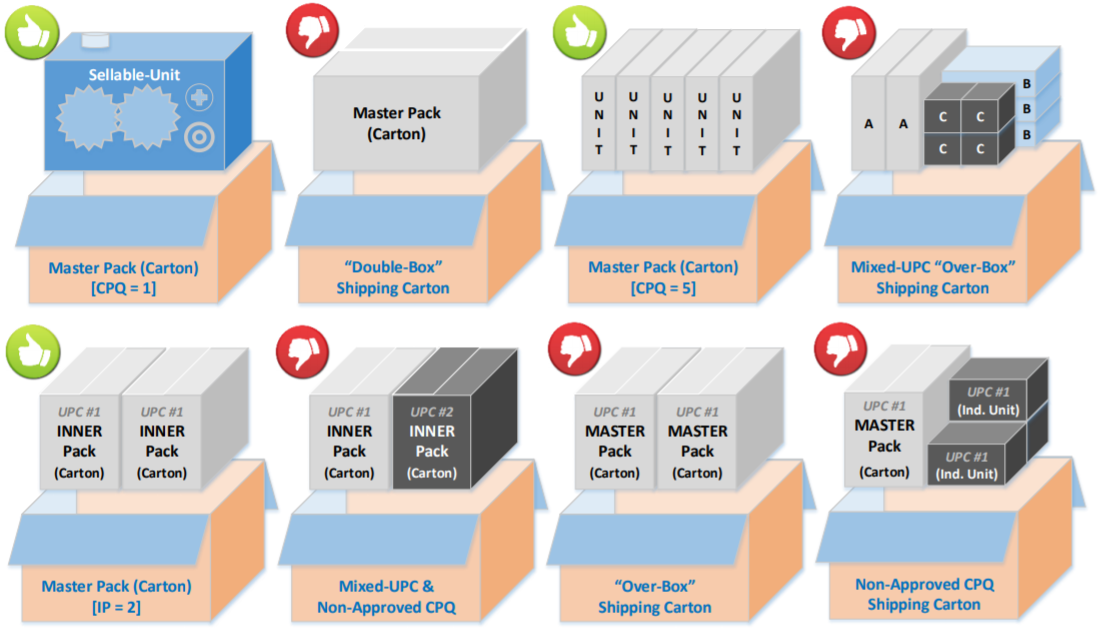
3.3 Carton Packaging & Protection
All shipping cartons in Master Packs (MP) or Inner Packs (IP) must be made of rigid recyclable corrugate.
Carton packaging and cushioning material must be able to maintain integrity and be free of damage through:
- Typical rigors in transit;
- Staging in high humidity and/or high-to-low temperature environments.
Do not use banding on individual cartons alone, as it can cause tearing to packaging. (TVs are an acceptable exception.)
Use strong 3” wide tape designed for shipping.
- Apply H-Taping method to seal all edges and seams:
- Apply once, parallel to, and on-and-along each center seams.
- Apply two strips of tape across both edge seams.
- Do not apply tape perpendicular to flap seam.
- Any other taping methodology will be reviewed as a potential pilferage.
Vendors and carriers are required to adhere to National Motor Freight Classification (NMFC) standards as found on www.nmfta.org
3.4 Box Strength Recommendations
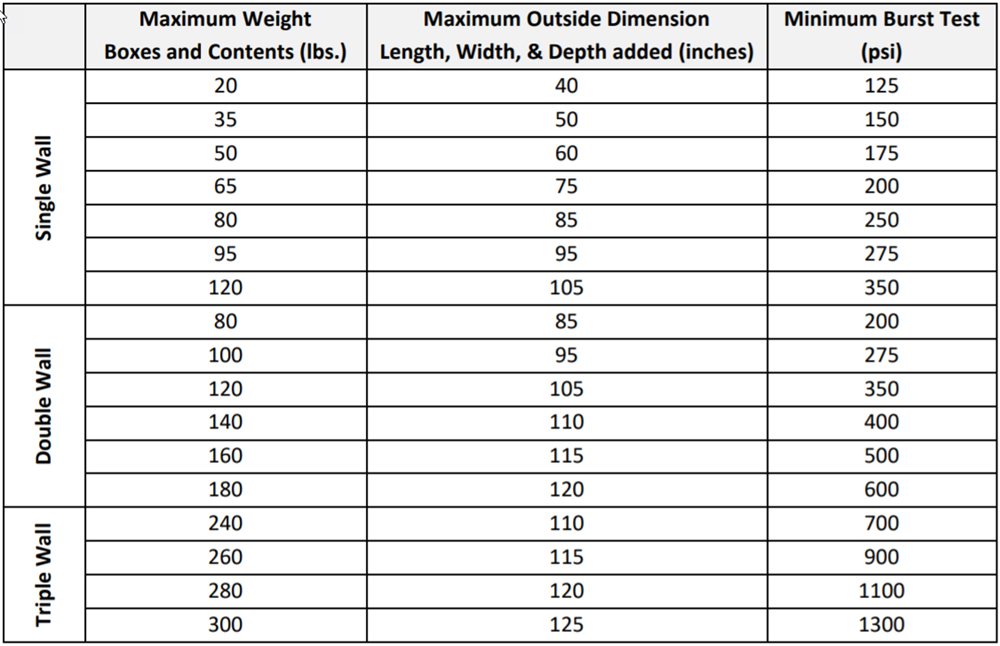
3.5 Conveyable Product Specifications

Master Pack cartons that fall within the Optimal Range (based on size and weight) enable Best Buy to most successfully convey and sort cartons, through both the retail and e-com conveyer system.
Cartons that are outside of the Optimal Range but inside the limits, can cause conveyer jams and bottlenecks, thus Best Buy asks that vendors consider Best Buy’s conveyable capabilities (and limitations) when selecting case pack configuration.
Cartons that are outside of the minimum/maximum Limits are not defined as conveyable and can lead to slower throughput processing, ultimately contributing to possible delayed customer fulfillment.
Best Buy encourages that banding not be used on conveyable unit product as frequent conveyer jamming can result.
The more efficiently Best Buy can process units through the distribution centers, the more effectively Best Buy can fulfill to customer demand.
3.6 On-Carton Information
For accurate and timely receiving, these 5 Critical Attributes are required on each Master Pack carton:
- Vendor Name and/or Vendor Icon
- Product Name or Model #
- Best Buy (Alpha) PO Number
- Case Pack Quantity [CPQ] – Required if the number of sellable-units (CPQ) > 1. Not required, if CPQ = 1.
- Trade Item Number & Barcode – Along with human readable number, barcode must be machine-readable from a distance of 4 feet. Do not mark through barcode. If the Master Pack carton’s sellable-unit quantity (CPQ) is…
- > 1, affix applicable ITF-14 barcode to the Master Pack carton
- = 1, affix applicable UPC-A barcode to the Master Pack carton
If any of the aforementioned is not present on either the Carrier Shipping Label or the on-carton (Master Pack carton) design, create “Receiving Labels” that will fulfill the 5 Critical Attributes.
To avoid a poor customer experience, do not affix labels directly onto the surface of sellable-units.
When possible, labels should either be placed on the outside surface of non-sellable cartons or exterior surface of wrap/film. Labels should not cross any carton seams or edges.
3.6.1 Carrier Shipping Labels
If shipping LTL, for each pallet, affix carrier shipping labels on 2 adjacent sides (excluding the top side).
When possible, labels should either be placed on the outside surface of non-sellable cartons or exterior surface of wrap/film. Labels should not cross any carton seams or edges.
For added criteria for small parcel shipping Reference Section 10.
Ship-To Address must follow the Best Buy location naming convention. Ex: “Best Buy RDC #725 – Dinuba”
3.6.2 Receiving Labels
Vendor-generated Receiving Labels are only required if the 5 Critical Attributes (mentioned above) are not available.
Label Size: Vendors must gauge appropriate size, but 4-inches wide by 3-inches tall is preferable.
Placement of unobstructed label:
- Where applicable a minimum of 2 inches from any edge of each carton.
- For product or pallet/unit loads that are greater than 60 inches high, the label should be placed no higher than 4-6 inches from the top, and no lower than 32-36 inches from the bottom.
Below are suggested examples for Receiving Labels. Format is not as important as the actual content.
3.6.3 Parcel Labels
For parcel shipments, Best Buy requires SSCC labels affixed to every carton.
There are two acceptable labelling formats for parcel shipments as shown below.
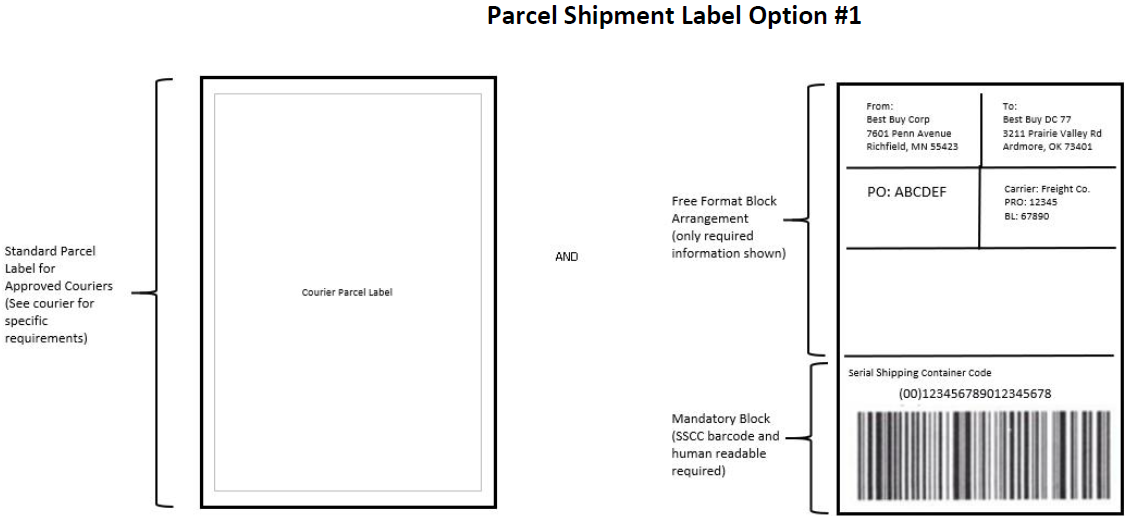
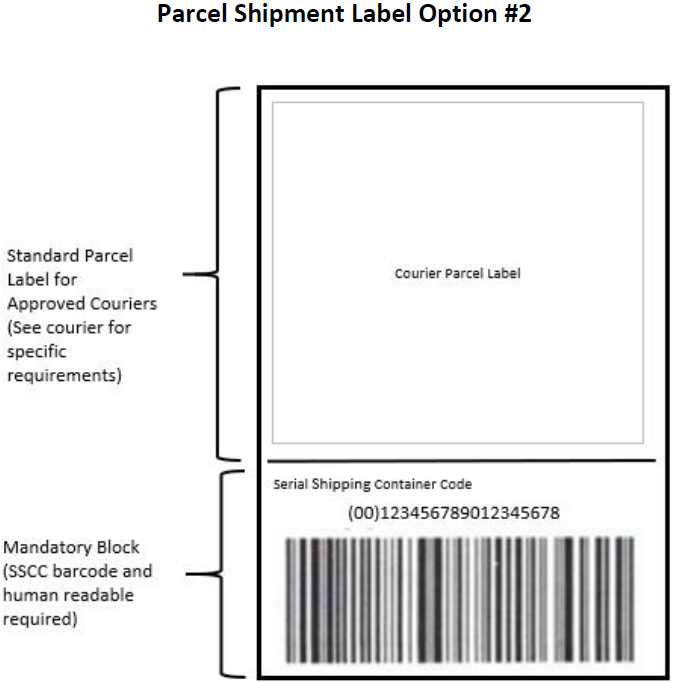
3.7 Iconography
Where applicable, manufacturer’s suggested special handling iconography should be on any and all shipping units.
